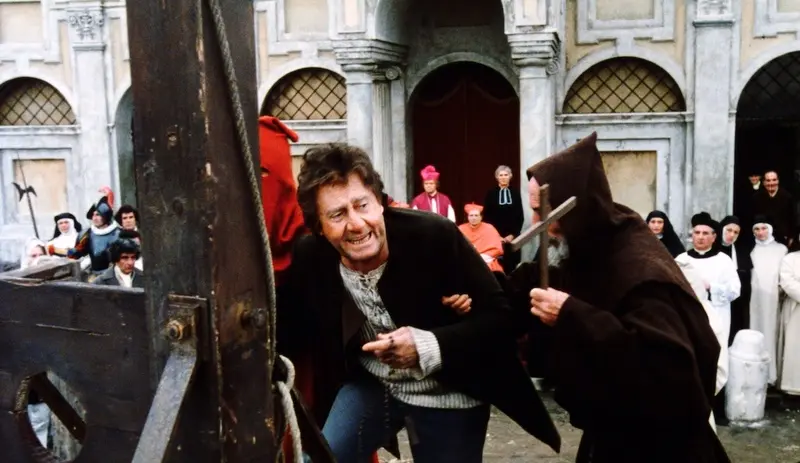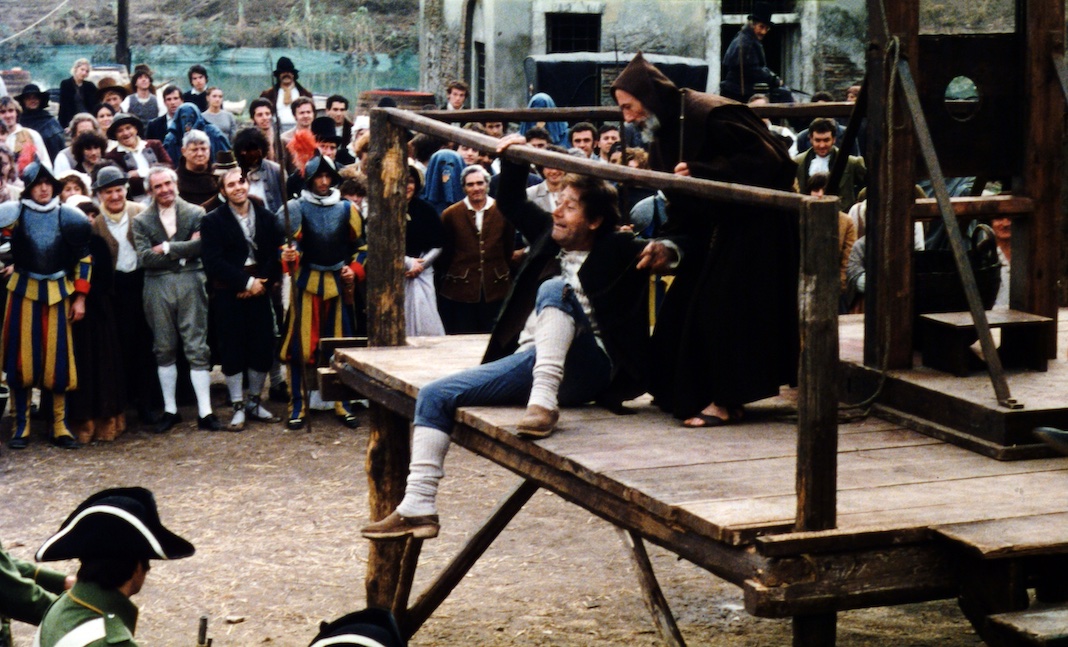
We use cookies
We use cookies and other tracking technologies to improve your browsing experience on our website, to show you personalized content and targeted ads, to analyze our website traffic, and to understand where our visitors are coming from.

Only when the Marchese del Grillo (Alberto Sordi) awakes can daily activities begin for all the people working at his sumptuous residence: the House of the Knights of Rhodes, in the Forum of Augustus, in what is called piazza del Grillo. His mother appears in this setting, seated at breakfast. Behind her, several external elements are recognisable, including the cupola of the Church of the Santissimo Nome di Maria in Trajan’s Forum and nearby buildings.

The Marquis’ activities include throwing boiling hot coins to the crowd one morning as a joke: he does this from the staircase of Palazzo Pfanner in Lucca, which stands in for a part of his residence in the film.
In the following scene, the Marquis rides in a carriage around the Claudian Aqueduct with the French officer Blanchard (Marc Porel). Shortly afterward, nears the ruins of the reserve of Monterano, the carriage is attacked by the outlaws of Don Bastiano (Flavio Bucci). The brigand, a friend of the Marquis, invites the two men to come inside at what is left of the Church of San Bonaventura.
The countryside of Tarquinia (province of Viterbo) offered the location for the exteriors of the crumbling farmhouse where the Marquis and his French friend find shelter: several set elements were added to the casale della Civita, near the via Aurelia bis, today abandoned. The interiors, however, have frescoes that are recognisable as belonging to the rooms of Villa Grazioli in Grottaferrata, a residence that dates to the latter half of the 1500s, today a luxury hotel. The Marchese throws boiling hot coins from a balcony of the villa which are gathered up by a “witchy” child without battling an eye.
The Marquis risks arrest in a taverna where he is playing cards with a group of dishonest people. The famous scene was shot in via del Velabro, by the arch of Janus, which stands in for the entrance to the inn.
At the end of a romantic evening with the Countess de Marchi, the Marquis takes her home in a carriage and hurriedly gets out at the Teatro di Marcello. He is headed for the nearby Ghetto, more precisely for via Sant’Angelo in Pescheria (“isn’t this via de li Banchi Vecchi?”), where he plays a nasty trick on a man by bricking up the door to his workshop and placing a toilet in front of it.

A poor carpenter who dares ask the Marquis to be paid for his work is put on trial and suffers public humiliation in piazza della Bocca della Verità. In the same square, preparations are being made for the execution of Don Bastiano and the poor coal-seller Gasperino: recreated at Cinecittà Studios to how it would have looked in the early 19th century, it shows the Church of Santa Maria in Cosmedin in the foreground with Castel Sant’Angelo in the background (which would not be visible from that perspective today).
The city is woken by the tolling of funeral bells mourning Pope Pius VII (Paolo Stoppa): the imposing bulk of Castel Sant’Angelo rises above the panorama of Rome with her cupolas. The Pope, however, is alive and residing in Palazzo dei Conservatori, in piazza del Campidoglio, which houses the Capitoline Museum. The Marquis is trying to solve an affair “of the heart” at Faustina’s house when he hears that the French army has taken the Pope out of Rome. A procession of the faithful praying for the Pope’s liberation enters into the Church of Santa Maria della Pace, behind piazza Navona: the recognisable columns of the semi-circular pronaos are also seen when Ricciotto (Giorgio Gobbi) talks to the Marquis leaning from a window above.
At the theatre, the Marquis meets Olympia (Caroline Berg) who is creating scandal with her presence on the stage, her voice (and face) replacing the eunuchs exclusively allowed to tread the boards in Papal Rome before the French invasion. This scene was shot in the Teatro Sociale in Amelia. He takes her to various places including the ancient Stadio Palatino, in the Colosseum Archaeological Park. Noting his family’s coldness to their new French overlords, the Marquis decides to join Olympia in France and begins a long journey, whereupon he discovers that the French are in retreat and so he returns to Rome (the meeting with the French army actually takes place on the banks of lake Vico, in the Viterbo countryside).
The Marquis stumbles while he is carrying the Pope, who has returned in triumph, on his throne with other noblemen up the staircase to the first floor of the Palazzo dei Conservatori. The buildings displaying drapes celebrating the return of the Pope are the exteriors of Palazzo Pamphili at piazza Navona, Palazzetto Le Roy and Palazzo Braschi in corso Vittorio Emanuele.
Only when the Marchese del Grillo (Alberto Sordi) awakes can daily activities begin for all the people working at his sumptuous residence: the House of the Knights of Rhodes, in the Forum of Augustus, in what is called piazza del Grillo. His mother appears in this setting, seated at breakfast. Behind her, several external elements are recognisable, including the cupola of the Church of the Santissimo Nome di Maria in Trajan’s Forum and nearby buildings.

The Marquis’ activities include throwing boiling hot coins to the crowd one morning as a joke: he does this from the staircase of Palazzo Pfanner in Lucca, which stands in for a part of his residence in the film.
In the following scene, the Marquis rides in a carriage around the Claudian Aqueduct with the French officer Blanchard (Marc Porel). Shortly afterward, nears the ruins of the reserve of Monterano, the carriage is attacked by the outlaws of Don Bastiano (Flavio Bucci). The brigand, a friend of the Marquis, invites the two men to come inside at what is left of the Church of San Bonaventura.
The countryside of Tarquinia (province of Viterbo) offered the location for the exteriors of the crumbling farmhouse where the Marquis and his French friend find shelter: several set elements were added to the casale della Civita, near the via Aurelia bis, today abandoned. The interiors, however, have frescoes that are recognisable as belonging to the rooms of Villa Grazioli in Grottaferrata, a residence that dates to the latter half of the 1500s, today a luxury hotel. The Marchese throws boiling hot coins from a balcony of the villa which are gathered up by a “witchy” child without battling an eye.
The Marquis risks arrest in a taverna where he is playing cards with a group of dishonest people. The famous scene was shot in via del Velabro, by the arch of Janus, which stands in for the entrance to the inn.
At the end of a romantic evening with the Countess de Marchi, the Marquis takes her home in a carriage and hurriedly gets out at the Teatro di Marcello. He is headed for the nearby Ghetto, more precisely for via Sant’Angelo in Pescheria (“isn’t this via de li Banchi Vecchi?”), where he plays a nasty trick on a man by bricking up the door to his workshop and placing a toilet in front of it.

A poor carpenter who dares ask the Marquis to be paid for his work is put on trial and suffers public humiliation in piazza della Bocca della Verità. In the same square, preparations are being made for the execution of Don Bastiano and the poor coal-seller Gasperino: recreated at Cinecittà Studios to how it would have looked in the early 19th century, it shows the Church of Santa Maria in Cosmedin in the foreground with Castel Sant’Angelo in the background (which would not be visible from that perspective today).
The city is woken by the tolling of funeral bells mourning Pope Pius VII (Paolo Stoppa): the imposing bulk of Castel Sant’Angelo rises above the panorama of Rome with her cupolas. The Pope, however, is alive and residing in Palazzo dei Conservatori, in piazza del Campidoglio, which houses the Capitoline Museum. The Marquis is trying to solve an affair “of the heart” at Faustina’s house when he hears that the French army has taken the Pope out of Rome. A procession of the faithful praying for the Pope’s liberation enters into the Church of Santa Maria della Pace, behind piazza Navona: the recognisable columns of the semi-circular pronaos are also seen when Ricciotto (Giorgio Gobbi) talks to the Marquis leaning from a window above.
At the theatre, the Marquis meets Olympia (Caroline Berg) who is creating scandal with her presence on the stage, her voice (and face) replacing the eunuchs exclusively allowed to tread the boards in Papal Rome before the French invasion. This scene was shot in the Teatro Sociale in Amelia. He takes her to various places including the ancient Stadio Palatino, in the Colosseum Archaeological Park. Noting his family’s coldness to their new French overlords, the Marquis decides to join Olympia in France and begins a long journey, whereupon he discovers that the French are in retreat and so he returns to Rome (the meeting with the French army actually takes place on the banks of lake Vico, in the Viterbo countryside).
The Marquis stumbles while he is carrying the Pope, who has returned in triumph, on his throne with other noblemen up the staircase to the first floor of the Palazzo dei Conservatori. The buildings displaying drapes celebrating the return of the Pope are the exteriors of Palazzo Pamphili at piazza Navona, Palazzetto Le Roy and Palazzo Braschi in corso Vittorio Emanuele.

Opera Film Produzione, Gaumont